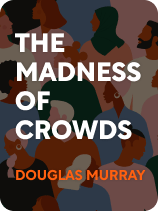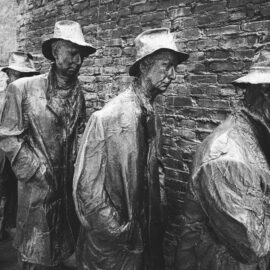

This article is an excerpt from the Shortform book guide to "The Madness of Crowds" by Douglas Murray. Shortform has the world's best summaries and analyses of books you should be reading.
Like this article? Sign up for a free trial here.
What’s intersectionality? Where does the adoption of this framework lead? Does it tend to bring people together or drive them apart?
The intersectionality framework has been around since the 1980s. Douglas Murray believes that it’s a pillar of the leftist ideology that’s tearing Western society apart. We’ll explore his views, as well as the perspectives of Ben Shapiro and the woman who first used the term—Kimberlé Crenshaw.
Keep reading to learn about the intersectionality framework, its aims, and its consequences.
The Intersectionality Framework
The second pillar of the New Ideology is the intersectionality framework. This theory again argues that multiple groups within society—particularly women, LGBTQ+ people, and racial minorities—suffer consistent, systematic oppression. It also states that certain people might fit into more than one category of marginalized identity (for example, they might be both Black and LGBTQ+) and thus experience overlapping discrimination.
Murray believes intersectionality’s supporters falsely insist that, the more discrimination a person experiences, the better they understand how oppression functions in society, thus making them capable of superior moral insights into how to fix it. Further, intersectional activists argue that, because marginalized groups share similar circumstances, they also share solidarity with each other in achieving emancipation from oppression. In working to free itself, each group helps liberate the others and thus removes oppression from society in general. Murray argues the contrary: that these groups often have contradictory and even antagonistic aims.
| The Origins of the Legal Term “Intersectionality” The term “intersectionality” was first used in the 1980s by legal scholar and activist Kimberlé Crenshaw. At the time, Crenshaw argued that black women experienced overlapping discrimination—due to their gender and race—in the workplace, particularly in the transportation industry. She concluded that both legal systems and society fail to acknowledge interwoven forms of discrimination like this. Therefore, the legal system was unable to either protect people from this discrimination or deliver justice after the fact. Crenshaw still discusses the intersectionality framework today. In a 2019 interview, she argued that, contrary to the belief of conservative authors, politicians, and pundits, intersectionality isn’t primarily focused on issues of personal identity. Rather, its goal is still to remove deep, structural inequities from society and the law. Not all critics of the intersectionality framework are wholly against Crenshaw’s definition of it. For instance, conservative pundit Ben Shapiro noted in 2019 that he believes Crenshaw’s concept to be valid and relatively uncontroversial. However, Shapiro, like Murray, objects to modern forms of intersectionality that encourage minorities to haggle over which group suffers worse from discrimination and what special accommodations they should get. In another interview, Shapiro echoes Murray’s idea that intersectionality restricts who can express certain views. For instance, he argues that divisive, intersectional politics encourages minorities to tell members of the dominant social class that they can’t discuss certain issues that only minorities experience (such as racism). |
Intersectionality Doesn’t Equal Solidarity
According to Murray, one contradiction lies in a basic premise of intersectionality: that all oppressed groups share common interests. Instead, these interests conflict far more often than they align, producing greater friction and divisiveness. The idea that society is rife with oppressed groups inevitably leads to certain groups imagining themselves as more oppressed than others. If one group feels more oppressed than another, it considers itself entitled to more concessions and attention, creating conflict with other oppressed groups.
Murray gives the example of a Cornell University activist group named Black Students United. In 2017, the group argued that the university should favor Black students of multi-generational US descent—in other words, the descendants of enslaved people—over Black students whose families had emigrated more recently. In this case, there was divisiveness within a single racial identity.
(Shortform note: Murray’s example highlights only one form of discrimination that leads to divisiveness within Black communities. Another is colorism, or anti-darkness, which refers to discrimination based specifically on skin tone—lighter, more European features are seen as superior to darker, Afrocentric ones. Some commentators argue that although Black individuals experience colorism that non-Black people perpetuate, it’s more demoralizing when Black people perpetuate colorism within the Black community. This form of colorism not only induces feelings of inferiority within one’s own community, but it also divides that community when it should instead be pursuing common economic and educational interests.)
| Intersectional Views on the Hierarchy of Oppressed Groups Some people agree with the basic premise of intersectionality without supporting the creation of a “hierarchy” of oppressed groups—in other words, groups needing to competitively establish themselves as more oppressed than others. They, like Murray, argue that this hierarchy is far more likely to pit marginalized groups against one another than to unite them. Further, critics of this hierarchy say that in instances where prejudice and discrimination do exist, becoming preoccupied with a possible hierarchy of oppression can empower the discriminator (for instance, a white supremacist). The discriminator is free to continue their oppressive activities while oppressed groups disagree with each other or jockey for position. |

———End of Preview———
Like what you just read? Read the rest of the world's best book summary and analysis of Douglas Murray's "The Madness of Crowds" at Shortform.
Here's what you'll find in our full The Madness of Crowds summary:
- That Western society is consumed by social justice and identity politics
- Why we must combat this ideology and restore opportunities for disagreement
- How conservative viewpoints are being silenced and possible remedies






